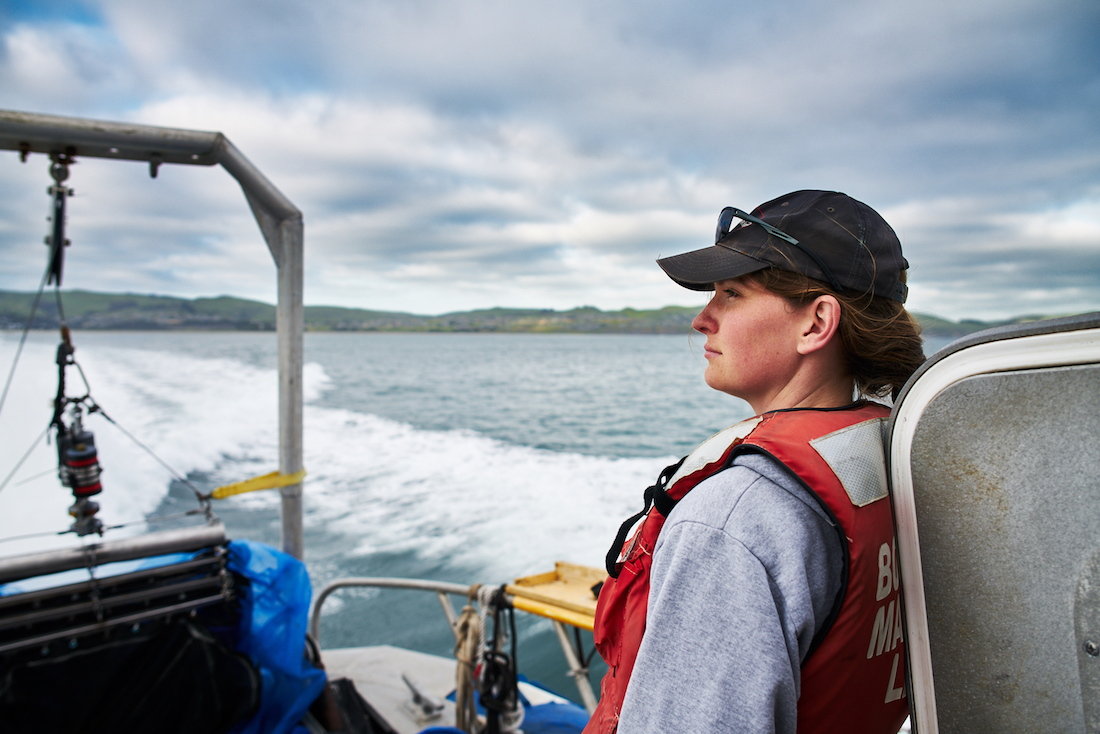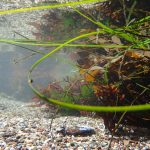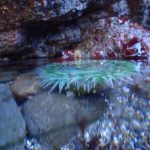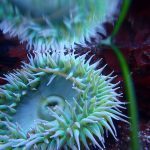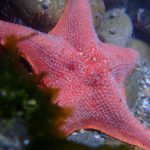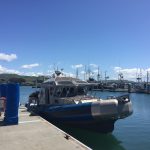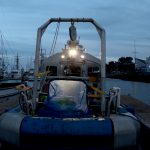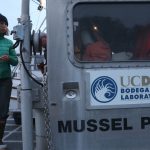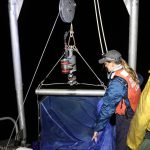By Rebecca Fanning
Medill Reports
Bodega Bay, California. I’ve spent the past several weeks working with marine ecologists –holding tiny porcelain crabs, named for their propensity for losing limbs, picking seaweed out of small buckets to be dried and weighed for an animal diet experiment, peering through microscopes at fish larvae and gazing at baby oysters, their shells smaller than the head of a tack. The stakes are higher for marine life in an era of climate change, and scientists are weighing the impacts as warming oceans acidify.
The road to UC Davis’ Bodega Marine Lab leads down a winding road, along a working harbor and past a series of seafood shacks, framed to the south by the calm waters of the bay. The lab itself sits on the edge of the Pacific Ocean, and, thanks to the annual upwelling which brings rich nutrients to the water’s surface, is surrounded by one of the most productive, life-filled marine ecosystems in the world. The lab is home to a thriving community of oceanographers, marine ecologists, naturalists, professors, PhD candidates, undergraduates and boat experts.
As an embedded reporter I saw firsthand the challenges of overnight research, discussed the struggle of attracting attention (and sometimes funding) to the less “charismatic” creatures, and mourned the loss of a beloved professor and marine ecologist whose mark on this community and the world will never be forgotten.
These journal entries are impressions and experiences from my reporting experience at the lab.
———
FISHING FOR SNAILS
April 20, 2018, Carmet Beach
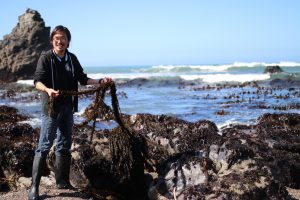
I’m out here collecting snails with Gabriel Ng. He needs 200 of the little guys for an experiment that he’s running. We’ve wedged ourselves against barnacle-covered rocks on the dry side of the rocky intertidal zone. And we’re both bent over, intermittently reaching into the tide pool below to gather snails, then measuring them. We frequently pick up a snail shell in time to see a few squirming legs disappear inside–hermit crabs love these shells and have taken up residence in many of the ones left behind by their slimy neighbors.
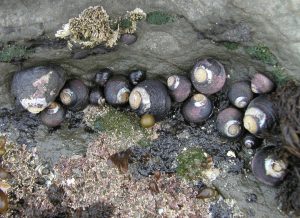
Tegula or turban snails as they’re named because of the distinct shape of the top of their shells, are part of Ng’s experiment around whether marine invertebrates will change their dietary habits when they sense danger. For Tegula, that danger often takes the form of a purple sea star.
As the oceans warm and become more acidic, animal behavior; from hunting to reproduction to habitat distribution is likely to morph and change. Understanding the impact of predator-prey relationships on entire ecosystems is one way that marine ecologists hope to prepare for this future of uncertainty.
Back at the lab Ng will measure these snails again before placing them in separate buckets. He’s interested in how fear of a predator impacts the way the snails consume algae, one of their favorite snacks. He wants to understand the impact of predators on populations two steps away in the food chain.
Sea star–>Snail–>Algae
Picture a predator like a sea star, which feeds on a snail, which feeds on algae. The more a sea star eats the snails, the more algae is able to grow. The algae’s predator has effectively been removed. Take away the snail and algae thrives, take away the sea star and algae is eaten by the overabundance of snail’s that remain. It’s a constant balancing act.
Underwater Vibrance, all found in the intertidal zone at Carmet Beach.
STRONGER THAN THEY LOOK
During a past experiment Ng wanted to keep the Tegula from fleeing the pool, even in the face of predators.
“So how do you keep a snail in a pool?” he asks. “A leash.”
He first used superglue to glue fishing line to the snail’s shell, and he glued the other side to a heavy weight. But the snails could pull free from the superglue, forcing him to use a stronger marine epoxy.
The power of the snail made him wonder. How much weight can these little snails handle? The size of a large marble, they don’t seem like they’re capable of much. But after a bit of experimenting, he found that one Tegula could pull 300 times its body weight, making them possibly the third-strongest animal in the world behind two types of beetles and ahead of the leafcutter ant. While this is in no way a confirmed scientific study, it did add to my respect for these little snails.
———
NIGHT COLLECTING
April 17, 2018, Pacific Ocean
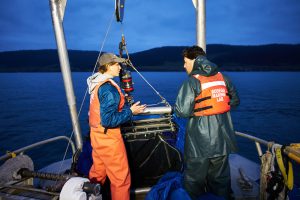
It’s nearly midnight and three of the six people on board our 42-foot research boat gaze out into the darkness, eyes fixed on the inky black of sky and water. After four hours at sea, the rocking of the boat and sloshing of waves has stirred up a deep nausea in a few of us. Two of us have been unable to hold on to our dinners, let alone help with the research. And there are four more sites to sample before we head back to shore. We’re looking at six hours more at sea, if we work quickly.
But Helen Killeen moves across the boat deck with ease. Writing notes on a clipboard, heaving heavy trawling nets up onto the deck, and sorting through piles of fish larvae pulled from the rumbling darkness of the Pacific Ocean beneath our feet.
This is the life of a marine ecologist. Collecting samples under the cover of darkness with a seasick crew and unstable footing. Logging depths, temperatures, salinity and other factors while fighting through her own sleep deprivation and bouts of nausea. All for the sake of science.
Killeen releases the Tucker Trawl, a fine net that drags along behind the boat, collecting unsuspecting fish larvae to be preserved in jars of ethanol and identified back at the lab.
CONNECTED WATERS
Our crew of five are here to help Killeen with research which will form part of her Ph.D .dissertation. She’s studying the impact of fish larvae behavior and major physical forces (tides, winds, currents) on the distribution, survival and recruitment of young fish populations.
Her big question is whether baby fish are passive creatures, happy to go with the flow of water in the ocean or if they’re more autonomous, in control of how and where they move.
Longterm, answering this question may help inform habitat protection and regulatory decisions, especially related to Northern California’s Marine Protected Areas (MPAs). In 1999, the Marine Life Protection Act established a set of statewide MPAs which rely on scientific evidence for their definitions and ongoing management. And in 2005, Bodega Marine Lab’s Susan Williams provided scientific context for lawmakers who sought to expand the boundaries of the Gulf of the Farallones and Cordell Bank National Marine Sanctuaries, two North Coast national marine sanctuaries which today cover 4,581-square miles of ocean–an area nearly twice the size of the state of Delaware.
Because of the fluidity of water, creating protected areas which connect with each other may be the best approach for fish populations. But the constant motion and fluidity of the ocean is more difficult to track than the migration of a land-based animal.
“If we only think about connectivity as where the currents go because we assume larvae drift passively, then that gives us one answer about where we should establish protected areas,” Killeen says. “But if we know that larvae behave in ways that prevent them from being just passive particles, that gives us another answer.”
FOOLING THE FISH
But here’s the thing – baby fish are smarter than you might think. Fish larvae, defined as the little creatures who have hatched out of fish eggs but are not yet feeding on their own, can dodge nets and avoid imposing boats, an adaptation that helps with survival against predators – and scientists. So in order to collect samples of fish larvae, we had to go at night. Under the cover of darkness the fish are less likely to see our nets coming, they are also less active at night, hence easier to catch.
Fish are visual predators and even from a young age they can see quite well. The size of the mesh nets matters — a too-large net will miss things and a too-small net will be too much drag and the water will pool into a “cone of pressure” in front of the opening.
“So organisms that are capable of swimming can swim out-of-the-way,” she says. “So you’ll notice that we don’t catch any really large fish because they can feel it.”
By sampling multiple depths at multiple distances from shore, Killeen hopes to chart patterns that certain fish follow in order to better understand their movements.
“You can be more intentional and effective in conserving populations if you’re conscious of and making good decisions about the connectivity between those populations.”
“You can be more intentional and effective in conserving populations if you’re conscious of and making good decisions about the connectivity between those populations,” Killeen says. “So the marine protected area network was designed with connectivity in mind , which is thought to make population more resilient in the long-term.”
GOING WITH THE FLOW
Unlike some ecologists whose field work involves intensive time in tide pools or a series of early mornings spent mucking around in sea grass beds, Killeen’s research requires not only an entire boat, but the crew to drive it and two volunteers to help her log data along the way. To add to the challenge, a storm or heavy swell at sea can delay her research for days or even weeks. And all of her research needs to take place during the spring–a season known for periods of intense waves and currents.
When Killeen started this research last year, she only finished one of her seven planned collection missions. So far this year she has completed two, with seven more planned for the coming weeks.
Killeen collects samples at five different sites along two transect lines at Bodega Bay and Stewart’s Point, lines charted intentionally to sample marine larvae at different depths and distances from shore. At each site she releases two trawls into the water — rectangular, finely webbed nets which drag along behind the boat before she pulls them up, emptying the “catch” into a small metal sieve and sorting through. The Tucker Trawl drags along the back of the boat with a net specially designed to collect small organisms without creating too much drag.
A fish with enough bones to “crunch on” is thrown back, its body past the larval stages and its life not worth sacrificing for the sake of research. Occasionally jellyfish end up in the nets and must be filtered out. And last year a sea cucumber was tangled in the gear–fun for the crew but useless for her research.
Back on the boat, an unfamiliar sound interrupted the crew’s rhythm.
“There are a lot of crab pots out here,” someone shouted. But it was too late. The sharp chain of a crab pot had cut through a piece of our gear, an essential part of the research. With only one of the five survey sites sampled, the mission wasn’t exactly what you’d call successful.
“I’m learning that that’s the way these things go,” Killeen says.
You can’t control the ocean.

